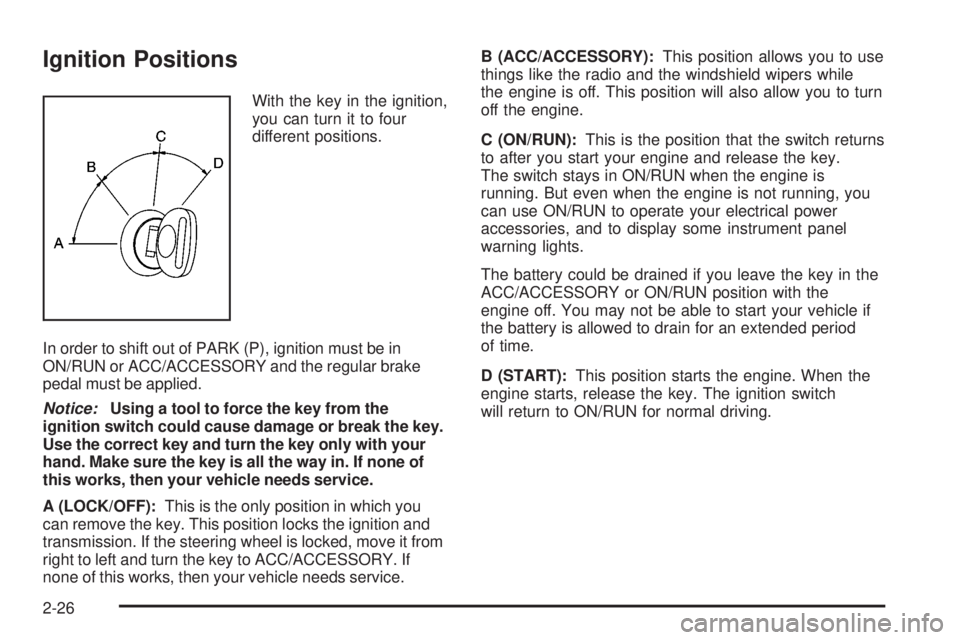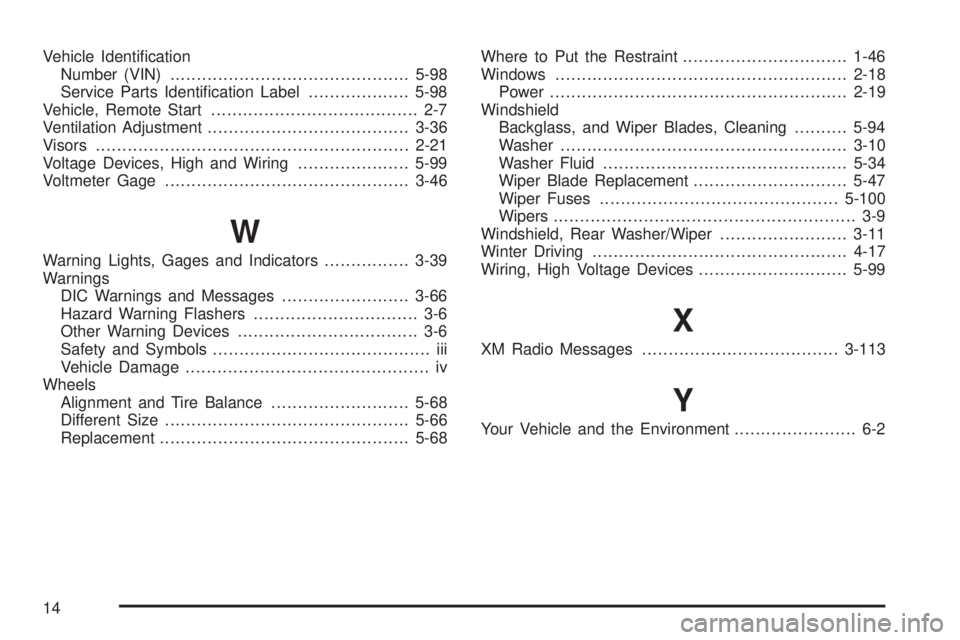2008 GMC ACADIA windshield wipers
[x] Cancel search: windshield wipersPage 108 of 472

Ignition Positions
With the key in the ignition,
you can turn it to four
different positions.
In order to shift out of PARK (P), ignition must be in
ON/RUN or ACC/ACCESSORY and the regular brake
pedal must be applied.
Notice:Using a tool to force the key from the
ignition switch could cause damage or break the key.
Use the correct key and turn the key only with your
hand. Make sure the key is all the way in. If none of
this works, then your vehicle needs service.
A (LOCK/OFF):This is the only position in which you
can remove the key. This position locks the ignition and
transmission. If the steering wheel is locked, move it from
right to left and turn the key to ACC/ACCESSORY. If
none of this works, then your vehicle needs service.B (ACC/ACCESSORY):This position allows you to use
things like the radio and the windshield wipers while
the engine is off. This position will also allow you to turn
off the engine.
C (ON/RUN):This is the position that the switch returns
to after you start your engine and release the key.
The switch stays in ON/RUN when the engine is
running. But even when the engine is not running, you
can use ON/RUN to operate your electrical power
accessories, and to display some instrument panel
warning lights.
The battery could be drained if you leave the key in the
ACC/ACCESSORY or ON/RUN position with the
engine off. You may not be able to start your vehicle if
the battery is allowed to drain for an extended period
of time.
D (START):This position starts the engine. When the
engine starts, release the key. The ignition switch
will return to ON/RUN for normal driving.
2-26
Page 143 of 472

Instrument Panel Overview...............................3-4
Hazard Warning Flashers................................3-6
Other Warning Devices...................................3-6
Horn.............................................................3-6
Tilt and Telescopic Steering Wheel...................3-6
Power Tilt Wheel and Telescopic Steering
Column......................................................3-7
Turn Signal/Multifunction Lever.........................3-8
Turn and Lane-Change Signals........................3-8
Headlamp High/Low-Beam Changer..................3-9
Flash-to-Pass.................................................3-9
Windshield Wipers..........................................3-9
Windshield Washer.......................................3-10
Rear Window Wiper/Washer...........................3-11
Cruise Control..............................................3-12
Exterior Lamps.............................................3-14
Delayed Headlamps......................................3-15
Daytime Running Lamps (DRL)/
Automatic Headlamp System.......................3-16
Fog Lamps..................................................3-16
Instrument Panel Brightness...........................3-17
Courtesy Lamps...........................................3-17
Dome Lamps...............................................3-17
Dome Lamp Override....................................3-17
Entry Lighting...............................................3-17
Delayed Entry Lighting...................................3-18
Delayed Exit Lighting.....................................3-18Parade Dimming...........................................3-18
Reading Lamps............................................3-19
Electric Power Management...........................3-19
Battery Run-Down Protection..........................3-20
Head-Up Display (HUD).................................3-20
Accessory Power Outlet(s).............................3-24
Power Outlet 115 Volt Alternating Current........3-25
Climate Controls............................................3-26
Climate Control System.................................3-26
Dual Automatic Climate Control System...........3-29
Outlet Adjustment.........................................3-36
Rear Air Conditioning and
Heating System.........................................3-36
Rear Air Conditioning and Heating System and
Electronic Climate Controls.........................3-38
Warning Lights, Gages,
and Indicators.............................................3-39
Instrument Panel Cluster................................3-40
Speedometer and Odometer...........................3-41
Tachometer.................................................3-41
Safety Belt Reminders...................................3-41
Airbag Readiness Light..................................3-42
Passenger Airbag Status Indicator...................3-43
Charging System Light..................................3-45
Voltmeter Gage............................................3-46
Brake System Warning Light..........................3-47
Section 3 Instrument Panel
3-1
Page 147 of 472

The main components of your instrument panel are listed here:
A. Air Vent. SeeOutlet Adjustment on page 3-36.
B. Multifunction Lever. SeeTurn Signal/Multifunction
Lever on page 3-8.
Windshield Wipers. SeeTurn Signal/Multifunction
Lever on page 3-8.
C. Instrument Panel Cluster. SeeInstrument Panel
Cluster on page 3-40.
D. Head-Up Display (HUD) Buttons. SeeHead-Up
Display (HUD) on page 3-20.
E. Audio System. SeeAudio System(s) on page 3-84.
Navigation/Radio System (If Equipped). See
Navigation/Radio System on page 3-115.
F. Exterior Lamps Control. SeeExterior Lamps
on page 3-14.
G. Hood Release. SeeHood Release on page 5-13.
H. Dome Lamp Override Button. SeeDome Lamp
Override on page 3-17. Instrument Panel Brightness
Control. SeeInstrument Panel Brightness on
page 3-17.
I. Cruise Control Buttons. SeeCruise Control
on page 3-12.
J. Tilt and Telescopic Steering Wheel. SeeTilt and
Telescopic Steering Wheel on page 3-6. Power
Tilt Wheel and Telescopic Steering (If Equipped).
SeePower Tilt Wheel and Telescopic Steering
Column on page 3-7.
K. Horn. SeeHorn on page 3-6.L. Audio Steering Wheel Control Buttons. SeeAudio
Steering Wheel Controls on page 3-128.
M. Driver Information Center. SeeDriver Information
Center (DIC) on page 3-57.
N. Dual Automatic Climate Controls. SeeDual
Automatic Climate Control System on page 3-29.
O. Center Console Shift Lever (If Equipped).
See “Console Shift Lever” underShifting Into
PARK (P) on page 2-36.
P. Hazard Warning Flasher Button. SeeHazard
Warning Flashers on page 3-6.
Q. Cupholders. SeeCupholder(s) on page 2-55.
R. Accessory Power Outlets. SeeAccessory Power
Outlet(s) on page 3-24.
S. Rear Window Wiper/Washer. SeeRear Window
Wiper/Washer on page 3-11. Traction Control
System (TCS) Disable Button. SeeStabiliTrak
®
System on page 4-6. Tow/Haul Selector Button
(If Equipped). SeeTow/Haul Mode on page 2-34.
Power Liftgate Button (If Equipped). SeePower
Liftgate on page 2-14.
T. Heated Seats Button. SeeHeated Seats on
page 1-5.
U. Passenger Air Bag status Indicator. SeePassenger
Sensing System on page 1-70.
V. Glove Box. SeeGlove Box on page 2-55.
3-5
Page 150 of 472

Turn Signal/Multifunction Lever
The lever on the left side of the steering column includes
the following:
GTurn and Lane Change Signals.SeeTurn
and Lane-Change Signals on page 3-8.
3Headlamp High/Low-Beam Changer.See
Headlamp High/Low-Beam Changer on page 3-9.
Flash-to-Pass. SeeFlash-to-Pass on page 3-9.
NWindshield Wipers.SeeWindshield Wipers
on page 3-9.
LWindshield Washer.SeeWindshield Washer
on page 3-10.
For information on the headlamps, seeExterior Lamps
on page 3-14.
Turn and Lane-Change Signals
The turn signal has two upward (for right) and
two downward (for left) positions. These positions
allow you to signal a turn or a lane change.
To signal a turn, move the lever all the way up or
down. When the turn is �nished, the lever will return
automatically.
An arrow on the instrument
panel cluster will �ash
in the direction of the
turn or lane change.
To signal a lane change, raise or lower the lever until
the arrow starts to �ash. Hold it there until you complete
your lane change. The lever will return by itself when
you release it. If you momentarily press and release the
lever, the turn signal will �ash three times.
If the arrow �ashes faster than normal as you signal a
turn or a lane change, a signal bulb may be burned
out and other drivers will not see your turn signal.
3-8
Page 151 of 472

If a bulb is burned out, replace it to help avoid an
accident. If the arrows do not go on at all when you
signal a turn, check for burned-out bulbs and then check
the fuse. SeeFuses and Circuit Breakers on
page 5-100.
Turn Signal On Chime
If either one of the turn signals are left on and you have
drove more than 3/4 mile (1.2 km), a chime will sound.
Headlamp High/Low-Beam
Changer
To change the headlamps from low beam to high beam,
push the turn signal/multifunction lever toward the
front of the vehicle.
This light on the instrument
panel cluster comes on
if the high beam lamps
are turned on while
the ignition is on.
To change the headlamps from high beam to low beam,
pull the turn signal lever toward the rear of the vehicle.
Flash-to-Pass
With the turn signal lever in the low-beam position,
pull the lever toward you momentarily to switch
to high-beam, to signal that you are going to pass.
If the headlamps are on, they will return to low-beam
when the lever is released.
Windshield Wipers
Clear ice and snow from the wiper blades before
using them. If they are frozen to the windshield, gently
loosen or thaw them. Damaged wiper blades may
not clear the windshield well, making it harder to see
and drive safely. If the blades do become damaged,
install new blades or blade inserts. For more information,
seeWindshield Wiper Blade Replacement on page 5-47.
Heavy snow or ice can overload the wiper motor.
A circuit breaker will stop the motor until it cools down.
Clear away snow or ice to prevent an overload.
Turn the band with the wiper symbol to control the
windshield wipers.
3-9
Page 152 of 472

8(Mist):Turn the band to mist for a single wiping
cycle. Hold it there until the wipers start. Then let
go. The wipers stop after one wipe. Hold the band
on mist longer, for more wipe cycles.
9(Off):To stop the wipers, move the band to off.
6(Delay):Turn the band to adjust the delay time.
The delay between wiping cycles becomes shorter
as the band is moved to the top of the lever. This can
be very useful in light rain or snow.
1 (Low Speed):Turn the band away from you to
the �rst solid band past the delay settings, for steady
wiping at low speed.
2 (High Speed):Turn the band further, to the second
solid band past the delay settings, for high-speed wiping.
Windshield Washer
J(Washer Fluid):Press the button located at the
end of the turn signal/multifunction lever, to spray
washer �uid on the windshield. The wipers clear the
windshield and either stop or return to the preset speed.
The ignition key must be in ACCESSORY or ON for
this to work. SeeWindshield Washer Fluid on page 5-34
Windshield Washer Fluid.
{CAUTION:
In freezing weather, do not use your washer
until the windshield is warmed. Otherwise the
washer �uid can form ice on the windshield,
blocking your vision.
WASHER FLUID LOW ADD FLUID is displayed on the
Driver Information Center (DIC) when the washer �uid is
low. SeeDIC Warnings and Messages on page 3-66.
3-10
Page 408 of 472

Use special care with aluminum trim. To avoid damaging
protective trim, never use auto or chrome polish,
steam or caustic soap to clean aluminum. A coating of
wax, rubbed to high polish, is recommended for all
bright metal parts.
Windshield, Backglass, and Wiper
Blades
Clean the outside of the windshield and backglass with
glass cleaner.
Clean the rubber blades using a lint free cloth or paper
towel soaked with windshield washer �uid or a mild
detergent. Wash the windshield thoroughly when you
clean the blades. Bugs, road grime, sap and a buildup of
vehicle wash/wax treatments may cause wiper
streaking. Replace the wiper blades if they are worn or
damaged.
Wipers can be damaged by:
Extreme dusty conditions
Sand and salt
Heat and sun
Snow and ice, without proper removal
Aluminum or Chrome-Plated Wheels
and Trim
Your vehicle may have either aluminum or chrome-plated
wheels.
Keep the wheels clean using a soft clean cloth with mild
soap and water. Rinse with clean water. After rinsing
thoroughly, dry with a soft clean towel. A wax may then
be applied.
Notice:Chrome wheels and other chrome trim may
be damaged if you do not wash your vehicle after
driving on roads that have been sprayed with
magnesium, calcium or sodium chloride. These
chlorides are used on roads for conditions such as
ice and dust. Always wash your vehicle’s chrome
with soap and water after exposure.
Notice:If you use strong soaps, chemicals, abrasive
polishes, cleaners, brushes, or cleaners that contain
acid on aluminum or chrome-plated wheels, you
could damage the surface of the wheel(s). The repairs
would not be covered by your warranty. Use only
approved cleaners on aluminum or chrome-plated
wheels.
The surface of these wheels is similar to the painted
surface of your vehicle. Do not use strong soaps,
chemicals, abrasive polishes, abrasive cleaners, cleaners
with acid, or abrasive cleaning brushes on them because
you could damage the surface. Do not use chrome polish
on aluminum wheels.
5-94
Page 472 of 472

Vehicle Identi�cation
Number (VIN).............................................5-98
Service Parts Identi�cation Label...................5-98
Vehicle, Remote Start....................................... 2-7
Ventilation Adjustment......................................3-36
Visors...........................................................2-21
Voltage Devices, High and Wiring.....................5-99
Voltmeter Gage..............................................3-46
W
Warning Lights, Gages and Indicators................3-39
Warnings
DIC Warnings and Messages........................3-66
Hazard Warning Flashers............................... 3-6
Other Warning Devices.................................. 3-6
Safety and Symbols......................................... iii
Vehicle Damage.............................................. iv
Wheels
Alignment and Tire Balance..........................5-68
Different Size..............................................5-66
Replacement...............................................5-68Where to Put the Restraint...............................1-46
Windows.......................................................2-18
Power........................................................2-19
Windshield
Backglass, and Wiper Blades, Cleaning..........5-94
Washer......................................................3-10
Washer Fluid..............................................5-34
Wiper Blade Replacement.............................5-47
Wiper Fuses.............................................5-100
Wipers......................................................... 3-9
Windshield, Rear Washer/Wiper........................3-11
Winter Driving................................................4-17
Wiring, High Voltage Devices............................5-99
X
XM Radio Messages.....................................3-113
Y
Your Vehicle and the Environment....................... 6-2
14